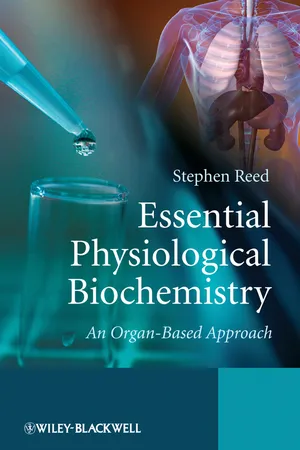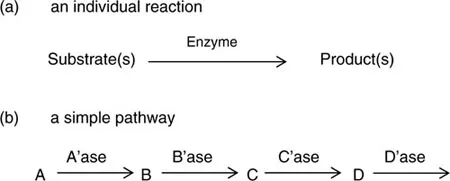![]()
1
Introduction to metabolism
Overview of the chapter
In this chapter we will consider definitions of metabolism; the biochemistry–physiology continuum. The concept of metabolic pathways and their organization and control of metabolism are likened to a road map involving ‘flow’ of substrates but with mechanisms to accelerate or slow down pathways or to direct substrates through alternative routes.
Introductions to enzyme kinetics and bioenergetics are given with explanations of key terms such as Km and Vmax; coenzymes, cofactors and inhibitors; typical metabolic reactions; free energy; exergonic and endergonic reactions, catabolism and anabolism.
Guidance on how to study metabolic pathways is given using glycolysis as a model pathway.
1.1 Introduction
Movement; respiration; excretion; nutrition; sensitivity; reproduction. These are the six criteria often used by biologists to define ‘life’. Whilst physiologists describe many processes of human biology at the tissue and organ level, a biochemist studies the same processes but at a ‘higher magnification’. To a biochemist, the six features listed above can all be described in terms of chemical events, so a useful definition of biochemistry is ‘the study of life at the molecular level’. The discipline of cell biology fits between physiology and biochemistry, but the three disciplines together form a continuum of knowledge and investigation.
Biochemical studies follow several themes. For example, investigations can be focussed on the chemical structures of molecules, (for example the structure of glycogen, DNA or protein conformation) or the structural inter-relationship between molecules (e.g. enzymes with their substrates, hormones with their receptors). The other branch of biochemical enquiry is into those numerous ‘dynamic’ events known collectively as ‘metabolism’, defined here as ‘all of the chemical reactions and their associated energy changes occurring within cells’. The purpose of metabolism is to provide the energy and building materials required to sustain and reproduce cells and thereby the organism.
It is estimated that there are between 2000 and 3000 different types of metabolic reaction occurring, at various times, within human cells. Some of these are common to all cell types whilst others are restricted to one or two particular tissues whose specialized physiological functions reflect the specialized metabolic changes occurring within them. Metabolism is a fascinating, yet at first sight, complicated process apparently representing a daunting challenge for the learner. For most students, it is unnecessary to learn every reaction in every pathway; what is important is that there an understanding of concepts of metabolism so that what appears to be a complicated set of reactions and pathways can be seen in terms of relatively few chemical and thermodynamic (energetic) principles. Metabolism may be likened to a journey; there is a starting place and a destination and there will be some important intermediate stops, perhaps where a change of mode of transport will be necessary, there will be points of interest and also places en route which deserve little or none of our attention. This analogy will be further developed later in the text. Furthermore, it is vital to realize that metabolism is adaptable; changes in physiological situations, for example fed or fasting, resting or exercising, health or ill- health will result in changes in particular aspects of metabolism.
The purpose of this book is to present metabolism in an organ-based fashion to make clear the links between biochemistry and physiology. By presenting metabolism in an appropriate tissue-context, the significance of pathways and their inter-relationships should be more meaningful.
1.2 Metabolic pathways
The term ‘intermediary metabolism’ is used to emphasize the fact that metabolic processes occur via a series of individual chemical reactions. Such chemical reactions are usually under the control of enzymes which act upon a substrate molecule (or molecules) and produce a product molecule (or molecules) as shown in Figure 1.1. The substrates and products are referred to collectively as ‘intermediates’ or ‘metabolites’. The product of one reaction becomes the substrate for another reaction and so the concept of a metabolic pathway is created.
Figure 1.1 Simple representation of a metabolic pathway. ‘Compound’ B is the product of the first reaction and the substrate for the second reaction, and so on. Capital symbols represent metabolic intermediates and lower case letters with the suffix ‘ase’ represent enzymes
Metabolism and the individual reactions which comprise a pathway represent a dynamic process. Terms such as ‘flow’, ‘substrate flux’, ‘rate’ and ‘turnover’ are all used to communicate the idea of the dynamic nature of metabolism.
The student should be aware that a pathway is essentially a conceptual ‘model’ developed by biochemists in order to represent the flow of compounds and energy through metabolism. Such models are simply ways of trying to explain experimental data. A potential problem in representing metabolic pathways as in Figure 1.1 is that there is an implication that they are physically and/or topographically organized sequences. This is not necessarily true. With some exceptions (described in Section 1.3), most enzymes are likely to be found ‘free’ within the cytosol or a compartment of a cell where reactions occur when an enzyme and its substrate meet as a result of their own random motion. Clearly this would be very inefficient were it not for the fact that cells contain many copies of each enzyme and many molecules of each type of substrate.
Think again about making a journey; a useful analogy is a road map of a city centre where there are main and subsidiary routes, one-way systems and interchanges, where traffic flow is controlled by signals and road-side signs. Very few people would attempt to learn, that is memorize, a complete route map, but learning the ‘rules of the road’ coupled with basic map reading skills and knowledge of main roads will enable most people to negotiate successfully a journey from one place to another. A complete diagram of intermediary metabolism appears to be as complicated as a road map of a city or region, that is a tangle of individual reactions with numerous substrates.
Understanding biochemical pathways is somewhat similar to map reading. The flow of traffic along roads and through the city is conceptually similar to the flow of substrates within the cell. Rather than visualizing cars, vans and trucks, think about the numerous carbon, hydrogen, nitrogen, phosphorus and oxyg...

